Ever since I started this blog almost a year ago (our first anniversary is rapidly approaching), I’ve toyed with the idea of writing a post along the lines of “The Ten Essential Children’s Books You MUST Have in Your Home Library.” It’s the kind of article that’s easy to write, it attracts traffic, and it can be a great discussion starter, if done right. (If done wrong, it can be trite, repetitive, and disposable.) However, every time the idea occurs to me, I find myself paralyzed when it comes to trying to define the criteria for the list. What makes a book essential? Will my definition of “essential” correlate to other parents’ definitions? How can I say that these ten books have more inherent value than every other book ever published? I’ve just never been able to tackle the topic in a way that makes me comfortable.
But, with all that said, I will say that, if your kid doesn’t have their own copy of Brown Bear, Brown Bear, What Do You See? by Bill Martin Jr. and Eric Carle, there is something truly significant missing from your home library.
Is Brown Bear, Brown Bear, What Do You See? an “essential” children’s book? To me and my subjective definition of “essential”, yes, it is. Why? There are a lot of reasons, but if I had to pick one, it would probably be this – it is a magical picture book to read aloud to a young child.
For younger readers (and I’m talking mostly about kids ranging from newborn to around three years old), it seems like most of the books targeted at their age group fall into one of FOUR main categories.
First, there are STORY books. These are books that – surprise, surprise – tell a story. They have a beginning, middle, and end. They follow the arc of a character from point A to point B. Maybe they have a message or moral to convey. Most books fall into this category – fairy tales, legends, Red Riding Hood, Madeline, Strega Nona, etc.
Second, there are (what I call) STIMULUS-RESPONSE books. These are books that are less structured around a story and are more structured around eliciting some kind of response or feedback from your kid. Pat the Bunny is an example – it’s a book that wants you to (wait for it) pat the bunny. Mo Willems’ Don’t Let the Pigeon Drive the Bus is another example. That picture book isn’t setting up a big character transformation or narrative adventure for the Pigeon. Rather, it wants its readers to yell out “NO!” and to answer the Pigeon when he begs to be allowed to drive the bus. These are books designed to encourage interaction. (Press Here is another great stimulus-response book.)
The third category is BASIC SKILLS books. Alphabet books, color books, baby face books, and word books all fall under this rubric. These are titles that are trying to convey fundamental education principles to children in the most interesting and engaging way possible.
The fourth and final category covers what I call CADENCE or RHYTHM reads. These are books, normally picture books, that care more about imagery, inflection, and atmosphere than story, interactivity, or life skills. These are titles with poetry in their souls. These are books that were simply made to be read aloud – books that are written in such a way that, when read out loud by a parent or guardian, they inspire a sense of calm and well-being in their young captive audiences. These are the ultimate bedtime reads – books with such an ingrained rhythm at their core that, under the right circumstances, they can lull an excited child to sleep.
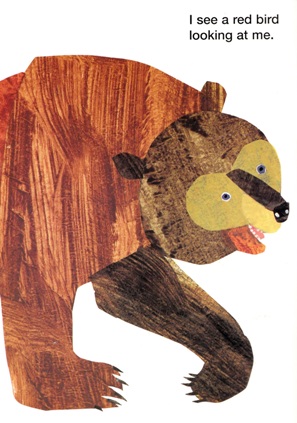
In the original manuscript, the brown bear ate the red bird. (There’s a 99.9% chance that isn’t true…)
Margaret Wise Brown’s Goodnight Moon is probably the best example of a cadence or rhythm read. It’s not trying to teach anything and there’s no real story to it. The book unfolds more like a nighttime prayer than anything else. When read aloud, Goodnight Moon comes across like a mantra – it’s a warm, inviting chant that calms the mind and body like a yoga instructor leading you through a post-workout cool down.
But I should note that, while I have a ton of respect for Goodnight Moon, it was never my daughter’s favorite nighttime rhythm read of choice. Her two favorite rhythm reads were always My Friends by Taro Gomi (which I’ve discussed before) and Brown Bear, Brown Bear, What Do You See? by Bill Martin Jr. and Eric Carle. (I should note that our family’s preferred edition of Brown Bear, Brown Bear is the board book version.)
So, what’s so special about Brown Bear, Brown Bear, What Do You See? For starters, it’s a beautiful book. Eric Carle is one of the best known children’s illustrators of all of time, and I think the image of his inquisitive Brown Bear is almost as iconic as his Very Hungry Caterpillar or the Grouchy Ladybug.
Brown Bear, Brown Bear is a book that, at its core, seems exceeding simple and, I’ll admit, it might even seem like it’s a basic skills book to some. We follow a series of animals, each represented by a primary color, as they tell us which animal they see next. We start with the titular Brown Bear…
Brown Bear, Brown Bear, What do you see?
I see a red bird looking at me.
We turn the page and then ask:
Red Bird, Red Bird, What do you see?
I see a yellow duck looking at me.
And so on and so forth. Like I said, Brown Bear, Brown Bear could be seen by some as just an ordinary animal and color book. A book that teaches kids that bears are brown and frogs are green. (And horses are blue… apparently.) But that reductive reading ignores the poetry at the core of the book. And I really do think that Bill Martin Jr.’s plain, direct text in Brown Bear, Brown Bear transcends basic color and animal facts and ends up acting as a meditative mantra more than anything else.
By definition, a mantra is described as either “a word or formula… chanted or sung as an incantation or prayer” or as “an often repeated word, formula, or phrase, often a truism.” And I feel that definition is an accurate description of what it’s like to read Brown Bear, Brown Bear, What Do You See? The book utilizes these simple, repeated factual phrases (“I see a brown bear, I see a yellow duck…”) to create this wonderful cadence, this palpable sense of plain-spoken calm. And that narrow bridge between a basic skills book and a work of poetry is particularly crossed in the book’s later pages, when Martin and Carle decide to change up the formula and show us a teacher and a group of children also observing the animals.
Following a spread with a goldfish, the book asks “Teacher, Teacher, What do you see?” and the teacher responds, “I see children looking at me.” The portrait of the teacher stares directly at the reader, and, true story, once while reading Brown Bear to my daughter, when she was finally old enough to ask questions, she turned and asked me, “Is she looking at me, Daddy?”
And I loved that response. I loved that a book about animals and their colors drew her in so deeply that she actually had to ask at one point, “Are they speaking directly to me?” That’s amazing.
I’m not a religious guy at all, but, when I used to read books like Goodnight Moon and Brown Bear, Brown Bear, What Do You See? to my daughter at bedtime, it always felt like the equivalent of doing our evening prayers. If you can find a great rhythm read, it feels like performing a rosary. Granted, the experience has significantly less dogma and way more duckies and bunnies, but the overall vocal power of the reading, of chanting that mantra, I think, remains the same.
So, if you have a young one, a kid still young enough that they can be lulled to sleep by the sound of their parents’ voice, I can’t recommend Brown Bear, Brown Bear, What Do You See? more highly. To some, it will seem like a very, simple boring text and, to others (like me), it will feel like a prayer. Maybe I’m just mythologizing a board book that my daughter took a shine to – a valid concern – or maybe not. Regardless, in the right hands (and with the right voice), Brown Bear, Brown Bear can be a powerful – one might even say “essential” – title in any home library.
###
Two Final Notes on Brown Bear, Brown Bear:
Note #1: I do know that there’s an audio version of Brown Bear, Brown Bear read by Gwyneth Paltrow out there. (Some editions of the book come with a CD of it.) I’m not going to rip on the lovely Ms. Paltrow, but, to me, I can’t imagine wanting to let someone else read this book to my kid. There is something just poetic and personal about a book like Brown Bear and – while I love audiobooks – it just doesn’t seem like the reading would have the same power coming from a recording.
Note #2: Martin and Carle have also collaborated on several other animal-themed books – Polar Bear, Polar Bear, What Do You Hear?; Panda Bear, Panda Bear, What Do You See?; Baby Bear, Baby Bear, What Do You See? – and they’re all pretty good reads. However, to be completely honest, while my daughter enjoyed them, they never inspired the same deep emotions in her that the original Brown Bear, Brown Bear did.
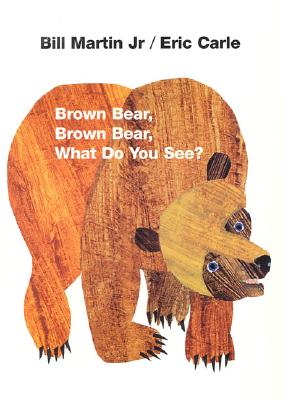
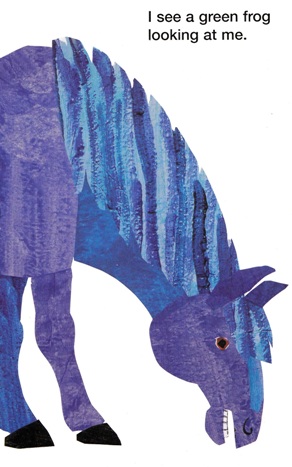
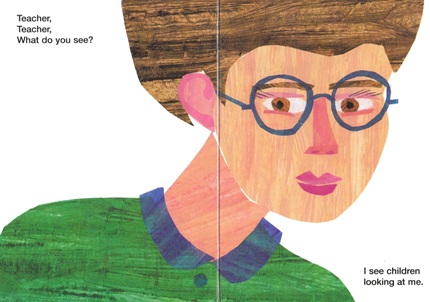
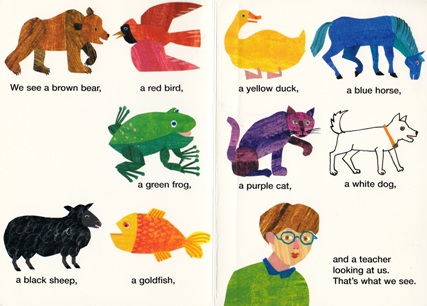
{ 1 comment… read it below or add one }
well said Tom – sometimes the simplest stories (and toys) are just the most enjoyable.
You must log in to post a comment.
{ 1 trackback }